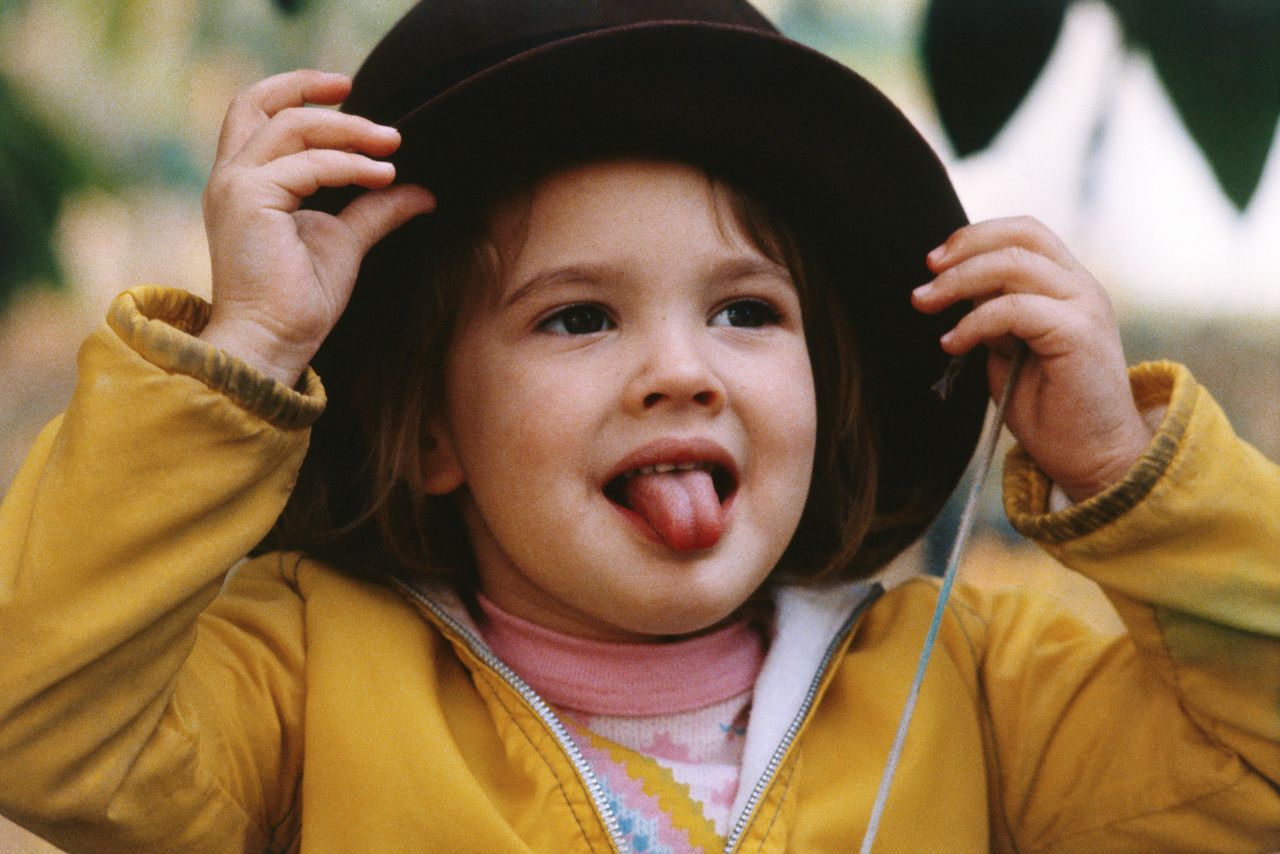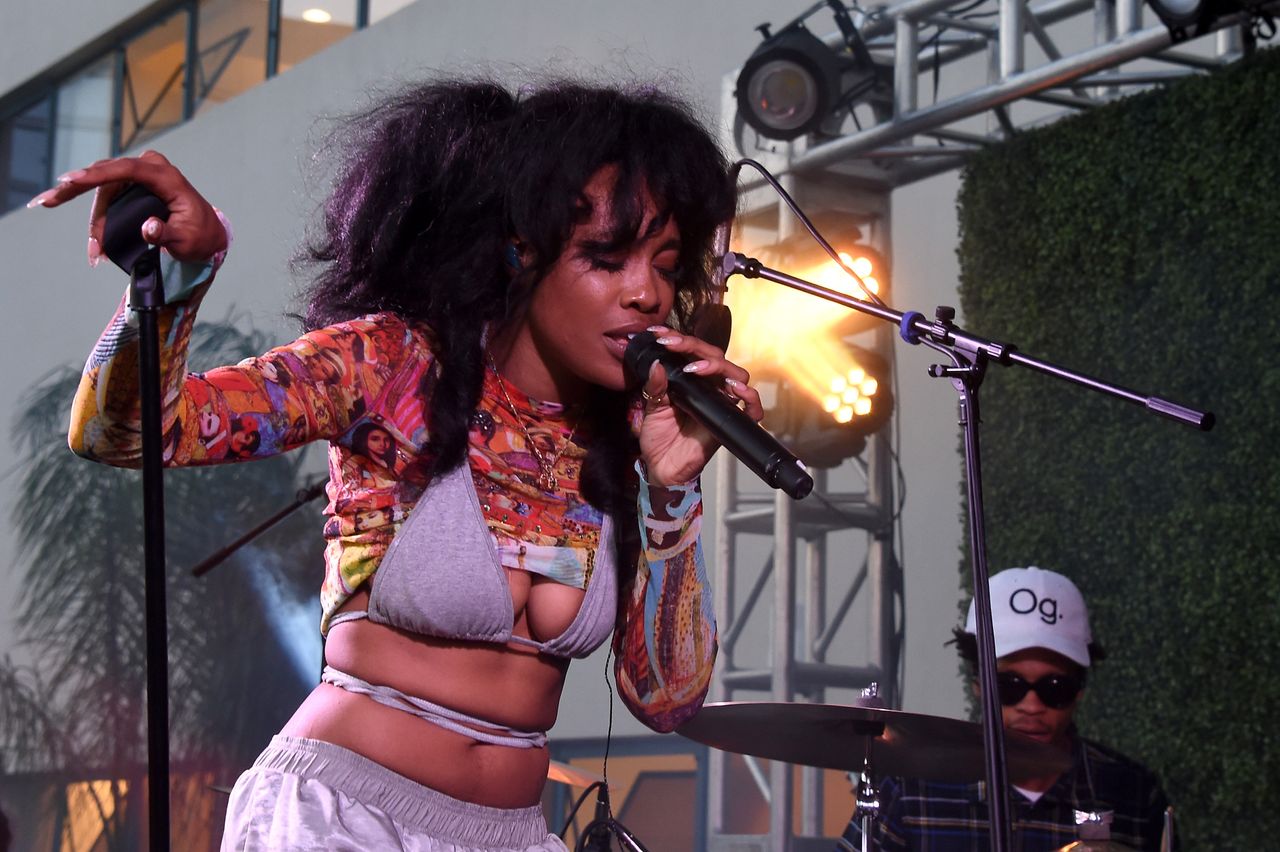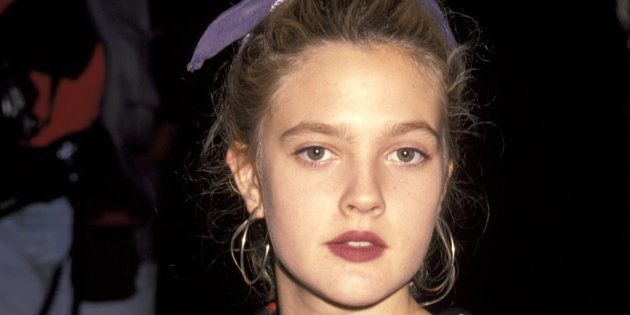The first single off SZA's intoxicating new album "Ctrl" is called "Drew Barrymore," named after the R&B singer's favorite actress. The song, whose chorus goes "Warm enough for ya outside baby, yeah / Is it warm enough for ya inside me, me, me, me?", addresses the way lopsided power dynamics in relationships yield low self-esteem, as SZA asks again and again if she's warm ― i.e. hot ― enough for her man's liking.
SZA has described Barrymore, who's not only referenced in the song title but makes a brief cameo in the music video, as an "endless inspiration," particularly due to her roles in '90s teen rom-coms that frame her as a pariah struggling to find a dude. "When I was watching Never Been Kissed," SZA told Vulture, "that's my experience. I was hella outcast in school. I was watching it like, 'Yes! Win for all of us!'"
Barrymore has, over the course of her 35-year career, become the one we root for. The one whose victories feel like our own. This could be, in part, because Barrymore's most iconic roles ― in films like "Never Been Kissed," "Charlie's Angels" and "The Wedding Singer" ― came out around the time millennial women were dressing up for middle school dances, trying on training bras and awkwardly fumbling through AIM chats with potential crushes. These PG-13 films were, at least for me, like instruction manuals, and Drew's characters ― alternating slightly between square and badass, clumsy and confident ― were my guides.
But you can't talk about Barrymore without talking about her life, the way it was broadcast so publicly since she was a kid and the ways her fans sought to relate to it. What does it take for a celebrity to become "relatable" when their lives are anything but? Today, many stars curate or communicate their personas to fans via social media. Like Kim Kardashian, whose chronic oversharing makes her unattainable lifestyle feel like home. Or Rihanna, whose electrifying lack of filters lets you bask in her glow. Or Lena Dunham, whose dutiful posting makes her feel like your most accomplished friend of a friend of a friend.
Barrymore's rise to fame, however, took place before the internet became the site where fantastical friendships between stars and fans blossom. And yet, having been an unwitting celebrity virtually since birth, her life was put on display from a young age, the gory details of her struggles and triumphs made public for all to imbibe and critique, making her somewhat of a proto-internet celebrity.
Born in 1975 in Los Angeles, California, Barrymore was the child of two actors; both her paternal grandparents and great-grandparents were actors as well. Her first-ever role was in a dog food commercial at the ripe old age of 11 months, but she became one of the most famous child celebrities after starring in "E.T." at 7. One of the earliest pictures of Barrymore available via the stock photo agency Getty shows the actress when she was just 4 years old:

A 1995 Rolling Stone interview described Barrymore, who followed up "E.T." with films like "Firestarter" and "Irreconcilable Differences," as "a 40-year-old in a 9-year-old's body." Emancipated from her parents ate age 14, she'd already struggled with alcohol, drugs, mental illness and depression. All very publicly.
Barrymore is neither the first nor the last child star to experience trauma as an offshoot of fame. Nor was she particularly unique in announcing her maturity to the world through public displays of sexuality. At age 17, Barrymore posed for her first nude magazine cover for Interview magazine. The same year she published a memoir titled Little Girl Lost.At 19, she had a Playboy cover and famously flashed David Letterman on his late night TV show.
Hollywood has the tendency to flatten female stars' identities into monolithic feminine stereotypes. As a kid, Barrymore was the fucked-up child star, the poor kid, the trainwreck. "At one point [her life] seemed like campy fun for the world to laugh at her," Chris Mundy wrote in that 1995 Rolling Stone interview. As she aged, her catch-all descriptor changed shape somewhat. She became the inevitable wild child, the bad girl. She played a "trashy girl"-turned-crazed-murderer in 1992′s "Single White Female"-esque thriller "Poison Ivy," and a sex worker who helps a colleague kill an abusive client in 1994′s "Bad Girls."
And yet, even during this phase of "rebellion," especially in the eyes of the young women who admired her, Barrymore exuded an authentic craving for affection that most take caution to keep tucked away. SZA certainly noticed. "She was all dark and she had her hair over her eyes, she was fucking up families and being weird, but she really just wanted to be loved," she said. "She was lashing out because she was lonely and pissed that her life was like this. I felt that."
And then, something in Barrymore's public persona began shifting yet again. As she left her teen years behind, she started to be seen less as a tragic figure, full stop, and more of "a living embodiment of tragedy and survival," as Mundy put it. Even at 20 years old, Barrymore understood her self and her destiny were public spectacles for an often vicious public. She asked Mundy: "Do you think people are interested in me because of the tragedy or because of the survival?"
The interview corresponded with the release of the 1995 film "Mad Love," in which Barrymore plays a "whimsical yet dark" manic-pixie type who attempts suicide, is placed in a mental institution and is sprung out by a dude who whisks her away on a romantic road trip to "cure" her pain. "My character goes into an institution, and her brain starts to deteriorate," Barrymore said. "How many other fucking actresses can relate to that? I can!"
How many other women can relate to that ― famous or not?

SZA, née Solána Rowe, was born 15 years after Barrymore in 1990 and grew up in the suburban town of Maplewood, New Jersey. Before she discovered music at 22, she was into gymnastics, jazz, science and, perhaps most of all, film. "I'm obsessed with movies," she told Teen Vogue in 2016. "So when I first started my album, I named all of my songs after actresses."
When "Ctrl" was finally released after extensive delays, "Drew Barrymore" was the only allusion to movies on deck. Yet the entire album evokes a nostalgia for school days and the feelings that ran high during that period of adolescence that maybe never ended ― insecurity, wobbly sexuality, openness, vulnerability and a hunger for love. "I just imagine this being the soundtrack to one of those movies. Cue Freddie Prinze, Jr.," she told fans at a show.
SZA's album addresses similar themes that defined the high school romantic comedy genre throughout the '90s and early 2000s. Only, instead of being written by rooms of old, white Hollywood men through hackneyed yet amusing cliches, SZA's songs come straight from her heart, her belly, her honeyed vocal chords. "I really wish I was a normal girl," she sings on a track titled "Normal Girl," bringing urgency and pumping blood to the stereotype of the awkward outcast.
For SZA and other women of her generation, who put their pictures, thoughts and feelings online for all the world to see, often receiving judgment, criticism and cruelty in return, Barrymore is a figure both relatable and inspirational. She was labeled and judged, she struggled and failed, often on a public stage. And yet her trials only fueled her as she subverted expectations and transcended categorizations to become an icon who is aspirational and decidedly imperfect. While she starred in Hollywood candy that tugged at our heartstrings in predictable ways, off camera, she was writing her own utterly unpredictable roles.
"I just want to be free," Barrymore said in the same '95 Rolling Stone chat. "That's the whole point I've been trying to make since I was a child, and I'm still making it."

In the late '90s, Barrymore transitioned from teenage bad girl to romantic lead, starring in a variety of films that cemented her status as a beloved Hollywood icon. In 1998, she starred opposite Adam Sandler in "The Wedding Singer" as a sweet, unassuming waitress; Christine Taylor playing her more promiscuous, Madonna-like best friend. Barrymore was a leading lady from there on out, whose plot lines determined she was worthy of love and happy endings.
Her next role was, literally, Cinderella in "Ever After," followed by a charming, pregnant fast-food worker in the beloved flop with a bizarrely convoluted plot, "Home Fries." No longer naughty, nasty or bad, Barrymore was accepted as wholesome, goofy, awkward and endearing.
Most Barrymore fans hold a special place in their hearts for 1999′s "Never Been Kissed." Barrymore stars as Josie Geller, a nerdy copy editor at The Chicago Sun Times who receives the unorthodox assignment of posing as a high school student and "finding the story there." Gellar, still haunted by her own miserable high school experience, when she was excluded, taunted and dubbed "Josie Grossie," ends up overcoming: She becomes popular, makes out with her English teacher, etc.
For women who are now in their 20s and 30s, who first saw "Never Been Kissed" as elementary or middle schoolers, the impact is huge. Some aspects of the film don't age particularly well ― for example, the part when a teacher makes advances on a girl who's ostensibly 17 ― but the film perfectly encapsulates the bygone era of romantic comedies, when makeovers were conducted, choreographed dances were performed and shit went down at prom.

Women around my age have a fierce devotion to Barrymore in part because her films came out at a time when we were impressionable and fanatic. I was 9 years old when "Never Been Kissed" came out. I remember it well because, during the scene in which Molly Shannon poses as a sex-ed teacher and demonstrates to students how to put condoms on bananas, my mom walked me and my burning cheeks out of the theater. When I finally got to watch the movie in its entirety, I was a disciple for life.
Romantic comedies are known to be formulaic, unrealistic and a little corny ― often in the best of ways. But Drew's mere presence adds a certain depth to the genre's sparkling surface, in part because viewers root for her not just within the confines of the film, but in her life. "I related to the fact that Drew came out among all these model-esque, aristocratic white women that were super-beautiful, but very typical," SZA told Rolling Stone. "We expect Michelle Pfeiffer, we expect Julianne Moore. But [Drew] just came through, and she was gorgeous and radiant and funny and honest."
When "Charlie's Angels" released in 2000, tween girls shaped their hands into three-fingered revolvers, posing in photos with their two best friends. Barrymore played Dylan, whose overt sexuality and defiant attitude were a callback to the actress' earlier days and just how far she'd come. To see her exhibit these qualities, without being vilified for them, was a glorious thing.
On one level, Barrymore represents nostalgia, happy endings, girls who are awkward and slightly out of place but still worthy of love. On another, she embodies a spirit of survival and self-transformation that many hope to emulate. Yes, she's a white, able-bodied, conventionally beautiful cis-woman of privilege. But in the terrain of Hollywood, she always felt like something of a black sheep.
As SZA put it: "She was really weird and quirky when she came out. Her teeth ― I had braces for most of my life, and I still fucked my teeth up after that somehow, not wearing my retainer. I was just always very self-conscious about that, not being smooth, not being cool enough. In every movie she played, she was always the oddball."
There aren't very many female role models whose missteps and contradictions are widely recognized to have fueled their growth and power. If a "female role model" does display addictive or depressive tendencies, fall in and out of love sloppily and whole-heartedly, transform her appearance on a whim, she is expected to grow out of it, to "find her way," to evolve into a stable and coherent version of herself. Yet Barrymore never grows out of her complexity. She never stifles her contradictions. She never quite reaches that perfect Hollywood ending.

In 2016 Barrymore endured her third public divorce, from art consultant Will Kopelman. She responded to the breakup with unfiltered vulnerability, telling Chelsea Handler: "When you get divorced, you're like, 'I'm the biggest failure. This is the biggest failure.' It's so shameful and hard to actually go through that, even privately."
Her description reflected the consistent way Barrymore has lived her erratic and paradoxical life: honestly, openly, hungrily.
As SZA said about her own album: "I'm talking a lot of grimy shit, but it's truth."
Through telling her truth, both in life and on screen, Barrymore became a hero for millennial women. Part bad girl, part Hollywood darling, part survivor, part outcast, part free spirit, Barrymore could never be pigeonholed into a single category. Since her childhood, viewers have watched Barrymore change and grow, not necessarily towards a specific point but toward a space of freedom, of love, where failure is OK. She is resilient and exuberant, consistently metamorphosing hardship into energy, heartbreak into love, pain into art.
For the next generation of young women struggling to define themselves to their peers and themselves, Barrymore offers up her own path generously and without censorship. "I don't have the energy to create a filter anymore," SZA told Complex, following Barrymore's lead. "If you don't define yourself, people do it for you. I don't want that."
One scene in SZA's "Drew Barrymore" video takes place at a house party, a 2017 redux of the red cup-laden scenes in movies like "Never Been Kissed" or that Freddie Prinze Jr. classic, "She's All That." As friends roll joints, drain wine bottles, bounce to the beat and make out in the kitchen, SZA smokes in the bathtub and zones out, mulling over her insecurities again and again.
She sings: "I get so lonely, I forget what I'm worth / We get so lonely, we pretend that this works / I'm so ashamed of myself think I need therapy-y-y-y." Like Barrymore, SZA speaks her shame, forcing it, at least somewhat, to change shape.
Eventually SZA takes a break from the party and sits alone on the roof when who should come up the stairs but Barrymore herself. Drew gives SZA a wordless smile and walks off. Though the interaction takes just seconds, SZA's face lights up immediately. But she doesn't just snap into a good mood and head back to the bottles. Instead she dials up the intensity of her self-reflective meditation, her voice growing louder and more abrasive as she sings: "Cause it's hard enough you got to treat me like this / Lonely enough to let you treat me like this / Do you really love me / Or just wanna love me down, down, down, down?"
Drew's presence doesn't make everything better. But she's there to help turn shame and pain into material, into the grimy shit. The stuff that helps us know ourselves and each other.

You can be highbrow. You can be lowbrow. But can you ever just be brow? Welcome to Middlebrow, a regular examination of pop culture. Read more here.
